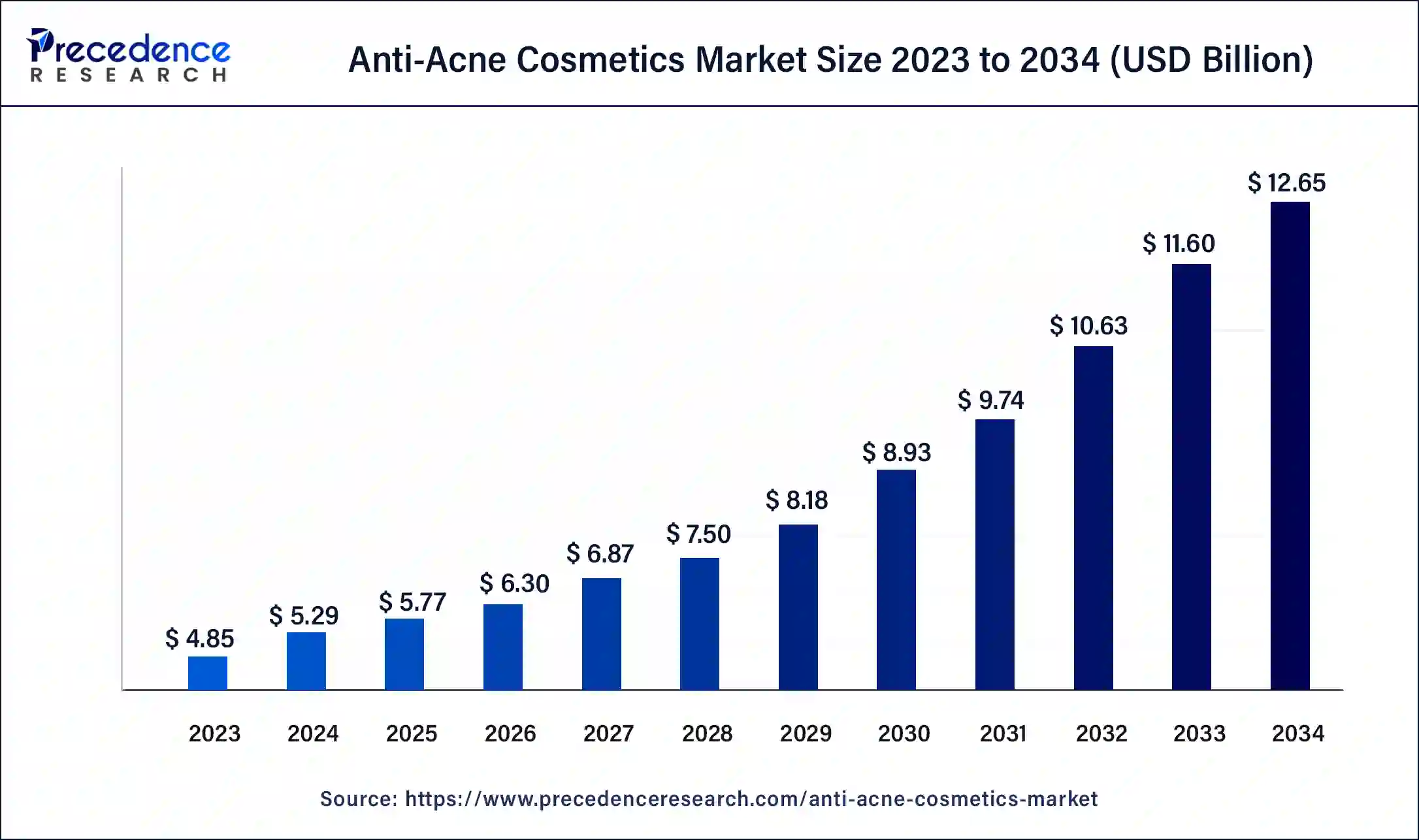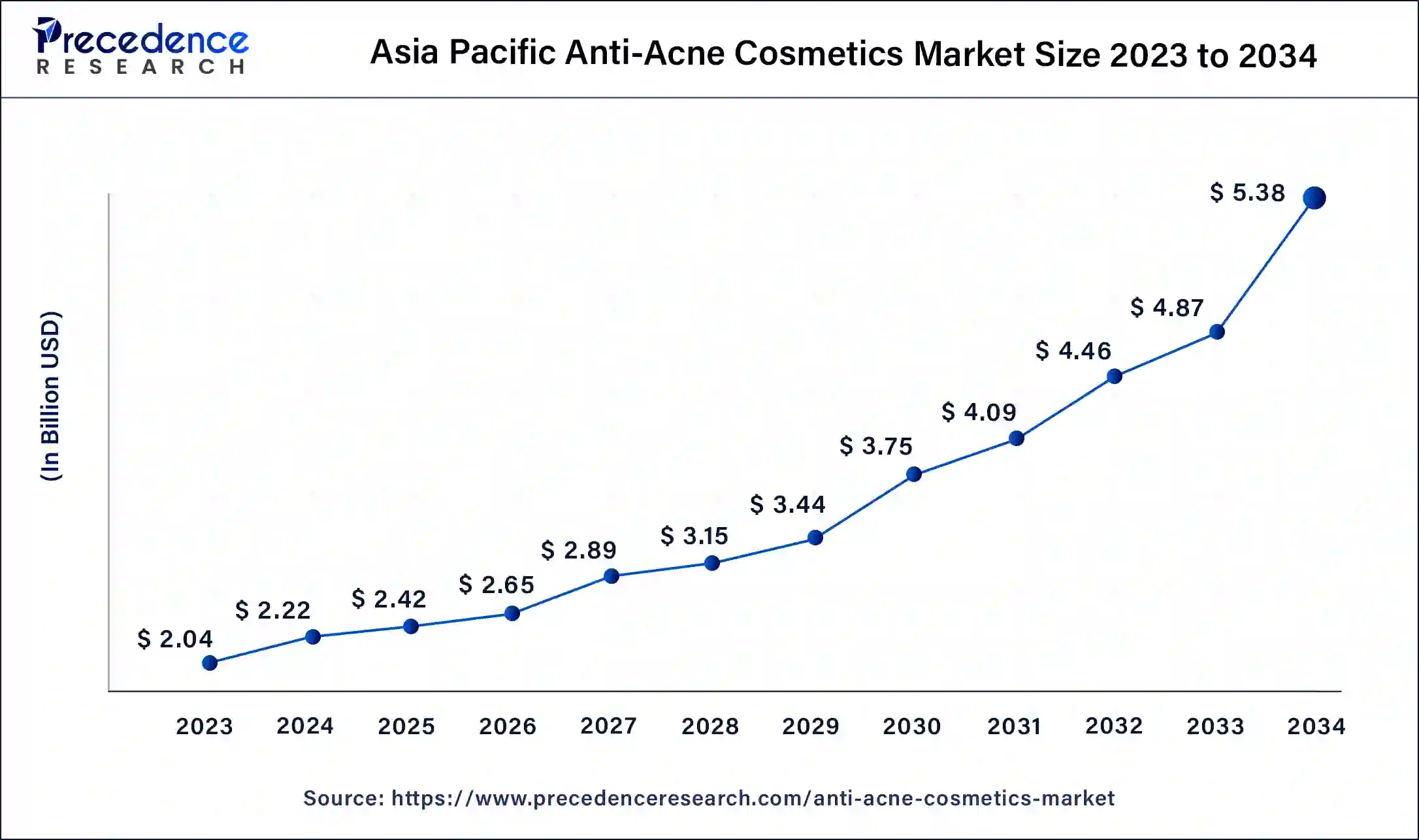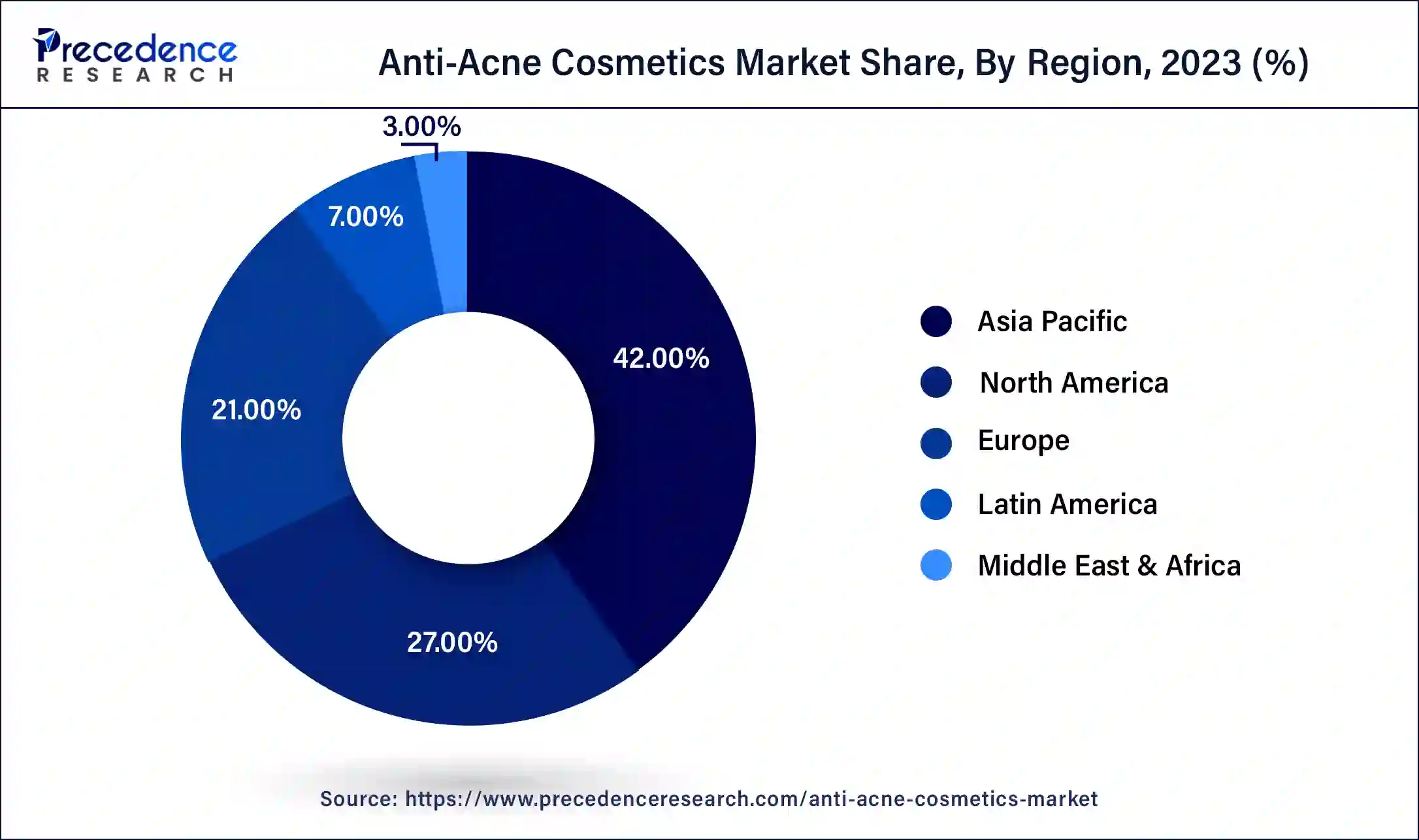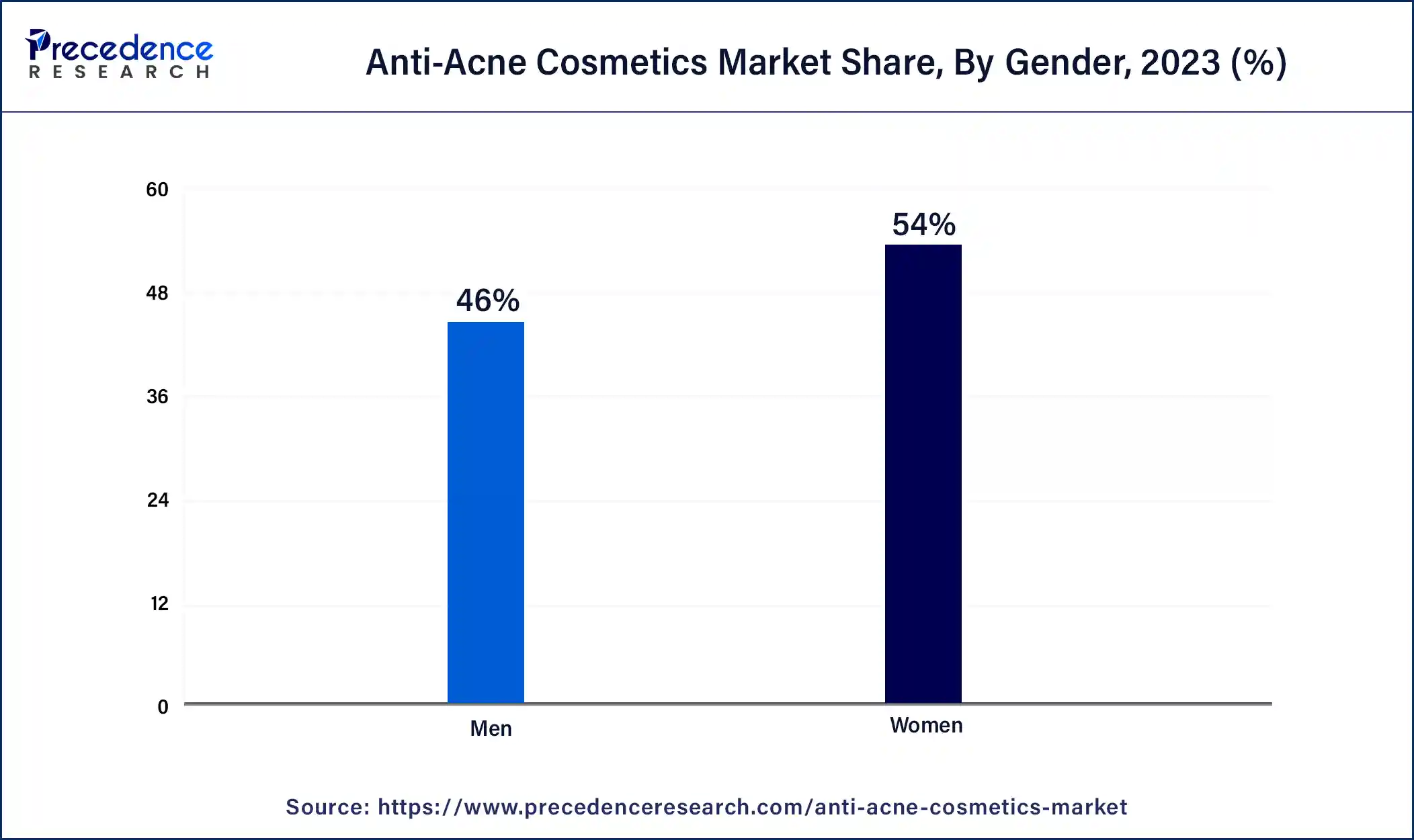List of Contents
Anti-acne Cosmetics Market Size and Forecast 2025 to 2034
The global anti-acne cosmetics market size is projected to be worth around USD 12.65 billion by 2034 from USD 5.29 billion in 2024, at a CAGR of 9.11% from 2025 to 2034. The rise in the anti-acne cosmetics space follows an overall increase in demand in the anti-acne cosmetics market globally.

Anti-acne Cosmetics Market Key Takeaways
- In terms of revenue, the anti-acne cosmetics market is valued at $5.77 billion in 2025.
- It is projected to reach $12.65 billion by 2034.
- The anti-acne cosmetics market is expected to grow at a CAGR of 9.11% from 2025 to 2034.
- Asia Pacific accounted for the largest market share of 42% in 2024.
- Europe is expected to host the fastest-growing market in the upcoming years.
- By products, the creams & lotions segment generated the highest market share of 43% in 2024.
- By products, the others segment is set to grow at the fastest rate in the market in the forecast period.
- By gender, the women segment contributed more than 54% of market share in 2024.
- By formulation, the inorganic segment captured the largest share of the global market in 2024.
- By formulation, the organic segment is expected to grow at the fastest rate in the market in the forecast period.
How AI is Being Used in Beauty and Cosmetics Industry?
AI tools analyze individual skin types, tones, and conditions using selfies or images uploaded by users. Based on this analysis, artificial intelligence (AI) algorithms recommend personalized skincare routines and products, ensuring that customers receive solutions tailored to their specific needs. Companies are using AI to create custom makeup products, such as foundations and lipsticks, by analyzing a user's skin tone and preferences. AI-driven tools suggest shades and formulations that match the user's unique complexion, enhancing the personalization of beauty products.
Asia Pacific Anti-acne Cosmetics Market Size and Growth 2025 to 2034
The Asia Pacific anti-acne cosmetics market size was exhibited at USD 2.22 billion in 2024 and is projected to be worth around USD 5.38 billion by 2034, poised to grow at a CAGR of 9.26% from 2025 to 2034.

Asia Pacific accounted for the largest share of the anti-acne cosmetics market in 2024. Asia Pacific is a large export market for U.S. and Europe-based products. Vietnam, Indonesia, and Malaysia are expected to see strong demand for anti-acne cosmetic products. Countries like South Korea, Japan, and China have some of the largest consumer bases for U.S. based products. North America has several established cosmetics and pharmaceutical companies which are increasingly exporting products to Asia Pacific. The robust research and development infrastructure in the region is giving rise to new and innovative treatments for acne. However, products from Asia Pacific are also gaining traction in the space, with a large ecosystem of skincare start-ups cropping up to meet the rising demand in the region.

How Is the Rise of K-Beauty Influencing Acne Care in Asia Pacific?
The Asia Pacific Anti-acne Cosmetics Market is expected to witness significant growth over the forecast period due to the changing consumer market and the emerging skincare technologies. Among the primary tendencies that power such growth, there is the ever-growing popularity of probiotic skincare, which is able to replenish the natural microbiome of the skin and diminish inflammation, which is highly effective in treating acne-prone skin. K-Beauty (Korean Beauty) is reshaping the skincare practices of the area because of its trend across the world.
India is emerging as a high-potential market, experiencing a rapid growth rate, is an increasing tendency towards skin care products recommended by dermatologists, particularly among consumers in urban areas. The Indian consumers are spending on gentle, non-comedogenic, pH-balanced natural formulations, which are suitable for acne-prone and sensitive skin types. The rising level of knowledge and sophistication of consumers can further lead to the increasing need for safe, effective, and science-based acne treatment products, which drives the Indian anti-acne cosmetics market.
Europe is expected to host the fastest-growing anti-acne cosmetics market in the upcoming years, with France and Germany leading the region's growth. France has a long-standing skincare culture with an emphasis among French consumers on maintaining healthy, blemish-free skin. Skincare is deeply rooted in French culture, and consumers are becoming aware of a variety of products.
Fashion and beauty brands are also a prominent part of French culture, with Paris still considered the global fashion and beauty hub. On the other hand, Germany has a sizeable presence in this market due to the country's status as the world leader in clinical trials and high R&D investment and patent applications. Germany leads pharmaceutical innovation in Europe.
Market Overview
Anti-acne cosmetics help prevent acne or alleviate the symptoms of acne on the skin. Anti-acne cosmetics include a variety of products like creams, cleansers, toners, face masks, spot treatment products, and more. Genetic factors, diet, certain endocrine disorders, pollution, stress, and even some skincare products can lead to acne, making it one of the leading dermatological issues globally.
Acne is a skin condition that occurs when hair follicles in the skin become clogged with oil, dead skin cells, and/or bacteria, causing inflamed, raised bumps. It has a high prevalence among adolescents, with nearly everyone having experienced acne at some point in their lives. Acne can frequently occur on the face, neck, shoulders, chest, and upper back. The development of organic anti-acne cosmetics made from natural ingredients that can cause less severe side effects is a great opportunity for growth in the anti-acne cosmetics market.
According to Yale Medicine, acne affects close to 85% of people between the ages of 12 and 24. As people age, acne tends to disappear by mid-20s. However, some may continue to experience it into adulthood. Over 25% of women and 12% of men in their 40s have also reported having acne.
Anti-acne cosmetics have become ubiquitous due to rising levels of pollution and overall environmental stressors, leading more people to have acne breakouts. Growing internet penetration, the rise of e-commerce, and increasing disposable incomes in emerging economies are driving demand for more skincare products. Innovations in the dermatological sector have led to the development of state of the anti acne cosmetics. Innovative delivery methods such as pimple patches and products tailored to various skin types are driving growth in the anti-acne cosmetics market.
Technology Advancement in the Anti-acne Cosmetics Market
The technological breakthroughs in the anti-acne cosmetic market over the past years whose based is increments of customer demand for an efficient, science-driven skin care product or cosmetic. Such innovations as microencapsulation, nanotechnology, and bioactive ingredient delivery systems led to a revolution in the efficacy of products. Besides, AI and machine learning are also introduced in skincare diagnostics, which allows brands to provide personal skincare product suggestions, depending on an individual's skin and acne levels and the conditions of their skin environment. There is also the emergence of smart packaging solutions, such as monitoring product use or ingredient stability to increase the user experience and long-term product stability.
Anti-Acne Cosmetics Market Growth Factors
- Rising pollution, dietary and lifestyle changes, and the rising prevalence of endocrine disorders have pushed demand for the anti-acne cosmetics market products and services.
- Growing trend of spending more on upscale skincare products, including anti-acne cosmetics for healthy-looking skin.
- Rising smartphone and internet penetration, giving individuals in emerging economies access to global e-commerce and retail platforms.
- Advances in skin pharmacology and the development of new acne treatments are also spurring demand for the anti-acne cosmetics market.
- The eroding of social stigma around using skincare and makeup products among women and men, especially in emerging economies, is driving growth in the anti-acne cosmetics market.
- A rise in disposable income among the middle class in regions like the Asia Pacific and changing beauty standards pushing consumers towards desiring unblemished skin are driving growth in the anti-acne cosmetics market.
- Lifestyle and dietary changes coupled with rising disposable incomes in emerging economies have led to growth in the anti-acne cosmetics market.
- A growing demand for organic alternatives in acne treatments is a major opportunity in the anti-acne cosmetics market.
How are Technology and Advancement Contributing to the Anti-Acne Cosmetics Market?
Technological advancements in the anti-acne cosmetics market feature popular AI for personalized skincare diagnostics. AI tools and AI-driven platforms match skin compatibility with the accurate analysis of ingredients of the product. AI-driven platforms help in learning the skin requirement and concern, to advise accurately on the skincare routine. It suggests products suitable for different types of skin. The product simulation and virtual try-on help in selecting products. The virtual try-on application enables users to check how the shades and other makeup would look on their skin.
The advancement of the anti-acne cosmetics market is organic and natural ingredients. The innovation adds nourishment and required moisturizer for sensitive skin. The devices and applications encourage development in the market. These technologies and advancements contribute to the skin health sector.
Market Scope
| Report Coverage | Details |
| Market Size by 2034 | USD 12.65 Billion |
| Market Size in 2025 | USD 5.77 Billion |
| Market Size in 2024 | USD 5.29 Billion |
| Market Growth Rate from 2025 to 2034 | CAGR of 9.11% |
| Largest Market | Asia Pacific |
| Base Year | 2024 |
| Forecast Period | 2025 to 2034 |
| Segments Covered | Product, Gender, Formulation, and Regions |
| Regions Covered | North America, Europe, Asia-Pacific, Latin America, and Middle East & Africa |
Market Dynamics
Drivers
Dietary changes, stress, and endocrine disorders are increasing the prevalence of acne.
Dietary changes, stress, and endocrine disorders are increasing the prevalence of acne and have led to a spike in pollution, changing diets, and a rising incidence of endocrine disorders. The increasing consumption of processed foods with a high glycemic load contributes to the development or worsening of acne.
The presence of certain endocrine disorders, such as polycystic ovary syndrome and congenital adrenal hyperplasia, raises androgen levels, which leads to more cases of acne. Increasing prescriptions for corticosteroids and anabolic steroids for various health conditions is also leading to a spike in the incidence of acne.
Rising disposable income and changing beauty standards
Countries in the Asia Pacific, like China, have been among the fastest-growing economies globally, and various other emerging economies, such as India, Singapore, Thailand, and Vietnam, are also seeing significant growth in the anti-acne cosmetics market. This growth is leading to a rise in middle-class populations.
- According to the Pew Research Center, China's middle class increased from 39.1 million people in 2000 to roughly 707 million in 2018. By 2020, China accounted for 37% of the global middle-class population. This has also led to a significant spike in purchasing power and demand for luxury products, including upscale skincare and cosmetics.
The rise of media and celebrity influencers, the prevalence of filters and airbrushing on social media, and ever-evolving makeup trends are changing beauty standards. Unblemished, flawless skin is now a universal ideal, with regimented skincare routines becoming popular. This push, coupled with higher spending power, is driving demand in the anti-acne cosmetics market.
Advances in skin pharmacology and new treatments for acne
Growing investment in healthcare worldwide has led to rising expenditure in dermatological research and development. The presence of acne can lead to anxiety, depression, low self-esteem, and thus, a lowering in overall quality of life due to emotional and mental associations with an individual's appearance. This has led to the development of new treatments and paved the way for advanced studies that will enable the further evolution of the anti-acne cosmetics market.
- Glenmark Pharmaceuticals Ltd launched a new topical Minocycline four percent gel under the brand name MINYM for treating moderate to severe acne in 2022.
- Zydus Lifesciences received final approval from the FDA in 2023 for its generic antibiotic Minocycline Hydrochloride extended-release tablets of strengths 55 mg, 65 mg, and 115 mg.
Restraints
Side effects, especially on sensitive skin
Although anti-acne products are growing in popularity worldwide, there are some noticeable side effects. Anti-acne cosmetics containing isopropyl myristate and its derivatives can cause skincare issues like irritation of the skin if overused. Adverse side effects like dryness, peeling, and increased photosensitivity from some ingredients like benzoyl peroxide and salicylic acid used in anti-acne products discourage consumers. The overuse of anti-acne cosmetics can cause skin irritation or allergic reactions. This restricts appeal and usage in the anti-acne cosmetics market.
Varying skin sensitivity among consumers
The efficacy of anti-acne cosmetics varies according to skin type, acne severity, and other genetic predispositions. This brings several complexities into treatment selection, with very few one-size-fits-all options available. This can lead to frustration among consumers and discourage them due to uncertainty of results. This can hinder the growth of the anti-acne cosmetics market.
Opportunities
Shift to organic ingredients
Consumers are becoming increasingly aware of the side effects of many of the chemicals used in the anti-acne cosmetics market. This has led to growing demand for organic products to treat conditions like acne. This provides a great opportunity for businesses to tailor their products to the demand for products with more natural ingredients.
Cannabidiol-based (CBD) products are becoming a popular ingredient in the anti-acne cosmetics market. CBD is derived directly from the hemp plant but is non-psychoactive. It has been linked to several beneficial pharmacological effects, including anti-inflammatory and antioxidant properties. Probiotics are also increasingly being incorporated into anti-acne treatments to promote skin health and reduce inflammation.
Product Insights
The creams & lotions segment dominated the anti-acne cosmetics market in 2024. Creams and lotions made for acne promote hydration, soothe inflamed skin, and mitigate excess oil production. Topical treatments are more readily available over the counter compared to oral medication. Consumers look for lightweight, non-greasy formulations that act as humectants and bind hydration to the skin. Some creams and lotions are also medicated, protecting the skin from skin conditions like psoriasis and eczema.
The others segment is set to grow at the fastest rate in the anti-acne cosmetics market in the forecast period. Face cleansers, gels, serums, and essential oils are included in the other segment. These products are tailored to a variety of skin types and provide better skin absorption. They also help unclog pores and slow down the development of sebum, preventing the formation of acne.
Gender Insights
The women segment led the global anti-acne cosmetics market in 2024. Women dominate the consumer base in the anti-acne cosmetics market. There has been a perpetually high demand among women for anti-acne treatments. A long-standing focus on aesthetics and appearance, as well as the rising frequency of skin disorders among women, are factors leading to their large share in the segment. Increasing use of various cosmetic products also leads to clogged pores and more sebum production, leading to more cases of harsh and irritable acne. These factors also contribute to the female consumer base being the fastest-growing in the anti-acne cosmetics market.

Acne is also more prevalent in women compared to men after adolescence since it is linked to hormonal changes occurring around the menstrual cycle. Premenstrual acne is common as estrogen and progesterone levels fluctuate, triggering a release of excess sebum (oil) from the sebaceous glands, which clogs pores and causes skin inflammation.
Formulation Insights
The inorganic segment captured the largest share of the global anti-acne cosmetics market in 2024. Inorganic ingredients have become an industry standard with an established base in the market.
The organic segment is expected to grow at the fastest rate in the anti-acne cosmetics market in the forecast period. The growing negative associations in consumer consciousness around artificial smells, sulfates, parabens, phthalates, petrochemicals, and synthetics have led to a push toward organic and natural products to treat conditions like acne.
Anti-acne Cosmetics Market Companies
- Clinique Laboratories, LLC.
- Ancalima Lifesciences Ltd.
- Guthy-Renker
- Murad, Inc.
- L'Oréal S.A.
- The Mentholatum Company, Inc.
- Kosé Corporation
- Johnson & Johnson
- LVMH SE
- Beiersdorf AG
- KOSE Corporation
- Rohto Pharmaceutical Co., Ltd.
- Cetaphil
- La Roche-Posay
- Estée Lauder Companies Inc.
- Sephora USA, Inc.
- Dermalogica
- Unilever PLC
Top Companies in the Anti-Acne Cosmetics Market
- CP Skin Health Group, Inc.: CP Skin Health Group, Inc. provides different skin care products on the theme of dermatological services and products covering acne, aging, and general skin health. Its products contain sophisticated formulations to enable the improvement of the appearance and performance of the skin.
- Obagi Cosmeceuticals: Obagi Cosmeceuticals LLC offers dermatologist-recommended skin care products in a range of categories, including skin health, aging, pigmentation, acne, and sun damage. Its formulations consist of advanced ingredients to improve the health and appearance of the skin and its overall complexion.
Recent Developments
- In April 2025, Dr. Chang introduced nine best Korean formulas, which will work wonders for all skin types. Korean oil cleanser and Korean moisturizer act as an anti-acne fighter. (Source - https://www.elle.com)
- In April 2025, MyMicrobiome introduced the new MyMicrobiome Derm Standard 26.10 acne, designed to evaluate cosmetic products for their impact on the delicate microbiome of acne-prone skin. (Source - https://cosmeticsbusiness.com)
- In April 2025, Tower 28 launched mineral sunscreen for sensitive and acne-prone skin. The rising demand for a skincare routine is benefiting brands to participate in the anti-acne cosmetics market. The concern about dull skin is attracting brands towards customer engagement and regional business expansion. (Source - https://wwd.com)
- In May 2024, L'Oréal announced innovative new skin technology for product testing that closely mimics the diversity of human skin and can simulate conditions such as eczema and acne.
- In December 2023, Glossier collaborated with Starface to create graphic adhesive hydrocolloid pimple patches. The collaboration features 32 stickers, including smiley faces, hearts, cherries, rainbows, and more, that come in a Glossier pink mirrored compact.
- In September 2023, Sun Pharma Canada Inc. launched PRWINLEVI in Canada. WINLEVI is the first and only androgen receptor inhibitor for the topical treatment of acne in patients 12 years of age and older.
- In August 2023, Topicals launched a sealed active scar primer containing medical-grade silicone, biomimetic peptide, and encapsulated retinol that help clear up acne scars.
- In July 2023, Kiehl's introduced a truly targeted acne-clearing solution, a medicated acne spot solution treatment that forms a transparent ‘liquid patch' over the affected area.
Segments Covered in the Report
By Product
- Mask
- Creams & Lotions
- Cleansers & Toners
- Others
By Gender
- Women
- Men
By Formulation
- Inorganic
- Organic
By Geography
- North America
- Asia Pacific
- Europe
- Latin America
- Middle East & Africa
For inquiries regarding discounts, bulk purchases, or customization requests, please contact us at sales@precedenceresearch.com
Frequently Asked Questions
Ask For Sample
No cookie-cutter, only authentic analysis – take the 1st step to become a Precedence Research client